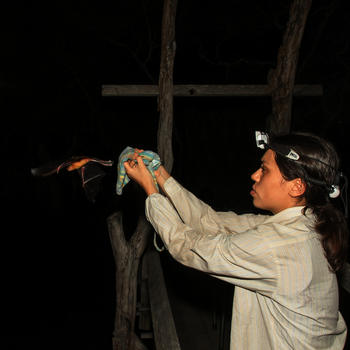Ahana Aurora Fernandez

Communication and Cognition in Bats (Knörnschild Lab)
Institute of Biology
Freie Universität Berlin
Ph.D. Candidate (Elsa Neumann Scholarship)
Biolinguistics, Animal Communication, Behavioral Ecology, Emballonurid Bats
Phonological syntax in babbling bouts of the vocal learning bat Saccopteryx bilineata
Behavioural biology is my main interest, and I am especially passionate about social communication, how it shapes and is shaped by social interactions between individuals, groups and populations. I am curious about the prerequisites which are needed for a certain communicative system to evolve and which events are influencing the development of communication.
For us, as humans, language (spoken or signed) is one of our most powerful tools and undoubtedly one of the key characteristics of our species (Hauser et al. 2002; Christiansen & Kirby 2003; Fitch 2010). Language allows sharing ideas and knowledge, interchanging concepts, influencing our daily life and culture, especially transmitting knowledge from one generation to the next, allowing to build on former achievements. The evolution of language is still a mystery. How and why did human language evolve? What are the prerequisites necessary to master language acquisition and use?
For the evolution of language key innovations emerged: speech (i.e. the ability to produce sound), syntax (i.e. the structure of sound) and semantics (i.e. the meaning). Additionally, other factors such as vocal imitation (i.e. our ability to imitate sounds) play an important role in human language acquisition. To gather knowledge about the evolution of human language, it is necessary to combine the results of different fields of research in a comparative approach - which is the case in the field of biolinguistics (Boeckx 2010). The comparative approach compares communicative systems of different species, investigating which and to what extent different keystones of human language have evolved (Yip 2006; Hauser et al. 2002; Margoliash & Nusbaum, 2009; Beníez-Burraco & Boeckx 2014).
One keystone which explains the vast expressive power of human language is the use of syntax, which allows us to combine smaller units into larger ones, applying combinatorics to make use of finite means for infinite use (Jackendoff 1999). Syntax in social vocalization systems has been investigated in primates (Zuberbühler 2002; Clarke et al 2006; Ouattara et al 2009), in cetaceans (Janik 2013; Rekdhal 2015) and birds (Clucas et al 2004; Templeton et al 2009; van Heijningen et al 2009; Engesser et al. 2015), and to a lesser extent in other species (but see Bohn et al. 2009; Kershenbaum 2012). Until now, research has focused on adult vocalizations in animals.
During my PhD I am investigating the vocal ontogeny of the adult repertoire in the bat Saccoperyx bilineata. This Neotropical bat species has been studied over the past 20 years (see Voigt et al. 2008 for a review). Saccopteryx bilineata has a rich vocal repertoire, comprising two adult male songs used in courtship and territorial defense (Behr & von Helversen 2004). During ontogeny, bat pups display a conspicuous babbling behavior (like plastic song in birds or canonical babbling in human children, Knörnschild et al. 2006). During ontogeny (pups are weaned at an age of about 12-14 weeks) pups of both sexes learn the adult male territorial song by imitating tutor males (Knörnschild et al. 2010). I am interested in the vocal ontogeny of the adult vocal repertoire, and the acquisition of syntactical rules in those songs.
During my PhD I want to investigate (1) whether Saccopteryx bats exhibit syntactical structures in their babbling bouts, and (2) whether phonological syntax (rules by which acoustic sounds are assembled into larger units, independent of meaning) changes during ontogeny and whether there is any difference between males and females. Furthermore, I want to know (3) whether there are differences in phonological syntax of Saccopteryx bilineata between three populations in Costa Rica (Pacific and Caribbean side, divided by a mountain chain) and Panama (Barro Colorad Island). I am investigating (4) the vocal ontogeny of the adult repertoire and (5) potential influences of the social environment on repertoire acquisition. To answer these questions, I am going to apply both a descriptive and an experimental approach; specifically, I plan to conduct playback experiments to investigate whether individuals discriminate between correct versus incorrect use of phonological syntax.
[4] Fernandez AA, Knörnschild M (2017) Isolation calls of the bat Saccopteryx bilineata encode multiple messages. Animal Behavior and Cognition 4: 169-186.
[3] Fasel NJ, Wesseling C, Fernandez AA, Vallat A, Glauser G, Helfenstein F, Richner H (2017) Alternative reproductive tactics, sperm mobility and oxidative stress in Carollia perspicillata (Seba's short-tailed bat). Behavioral Ecology and Sociobiology 71: 11. doi:10.1007/s00265-016-2251-7.
[02] Knörnschild M, Eckenweber M, Fernandez AA, Nagy M (2016) Sexually selected vocalizations of Neotropical bats. In: Sociality in Bats (J. Ortega, ed.). Springer Press, NY. Pp. 179-195.
[01] Fernandez AA, Fasel N, Knörnschild M, Richner H (2014) When bats are boxing: aggressive behaviour and communication in male Seba’s short-tailed fruit bat. Animal Behaviour 98: 149-156.
